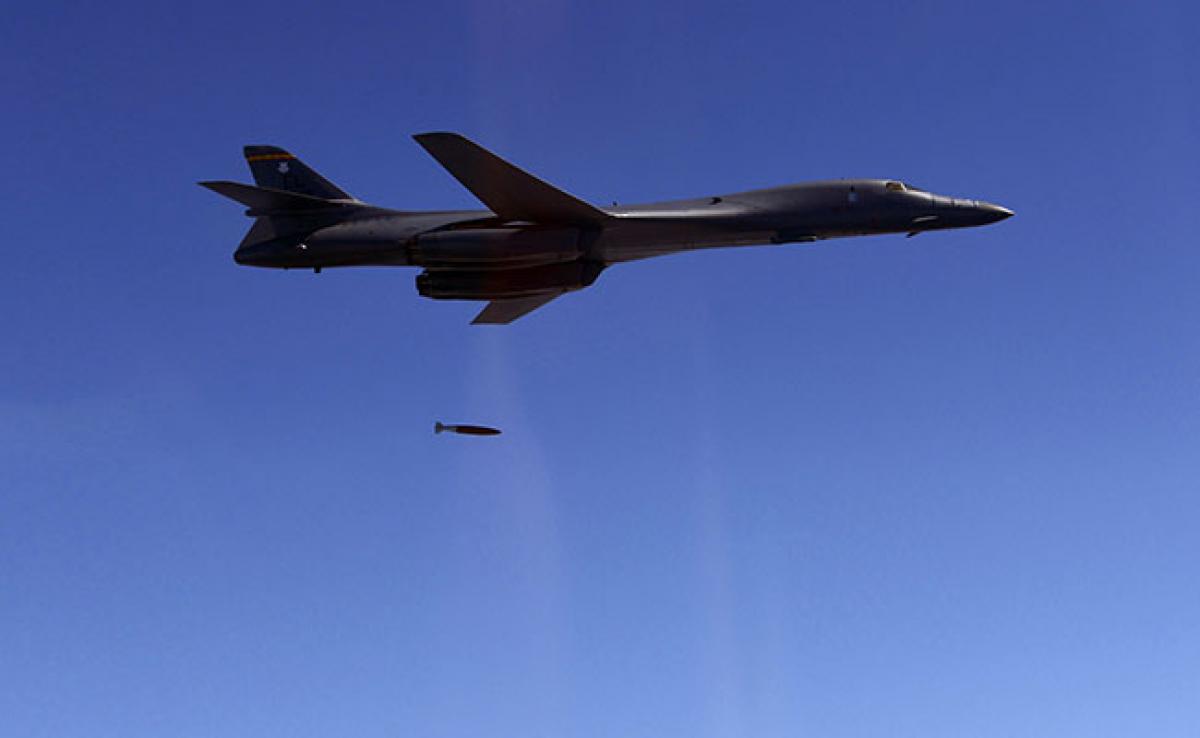Live
- First Impressions and Unboxing of the MacBook Pro M4: A Powerhouse for Professionals and Creators
- China Gears Up for Potential Trade War Amid Trump’s Tariff Threats
- Small Farmers Gain Less by Selling to Supermarkets: Study Reveals
- Why Despite the Controversy, America Is Anticipating the Mike Tyson vs. Jake Paul Fight
- Sanju Samson and Tilak Varma Shine: Record-Breaking Feats in 4th T20I Against South Africa
- India Urges $1.3 Trillion Annual Climate Support for Developing Nations
- Bad air: 106 shuttle buses, 60 extra Metro trips planned to make Delhiites give up cars
- WHO reports declining monkeypox cases in Congo
- CM Attends Kotideepotsavam on Kartika Purnima
- PKL Season 11: Raiding trio of Devank, Ayan, Sandeep help Patna Pirates rout Bengal Warriorz
Just In

South Korea said its air force conducted an exercise with two US nuclear-capable bombers above the Korean peninsula on Thursday, two days after a North Korean missile fired over Japan sharply raised tensions.
South Korea said its air force conducted an exercise with two US nuclear-capable bombers above the Korean peninsula on Thursday, two days after a North Korean missile fired over Japan sharply raised tensions.
The drills, involving two supersonic US B-1B bombers, four US stealth F-35B jets as well as South Korean fighter jets, came at the end of annual joint US-South Korea military exercises focused mainly on computer simulations.
North Korea strongly objects to the exercises, which it sees as a preparation for invasion and has responded with a series of threats and missiles launches in recent weeks.
US President Donald Trump has responded with his own threats, warning North Korea it would face "fire and fury" if it threatened the United States and that the US military was "locked and loaded" in case of any provocation.
Trump on Wednesday declared "talking is not the answer" to resolving the long-standing impasse with North Korea.
"The US has been talking to North Korea, and paying them extortion money, for 25 years," Trump, who last week said North Korean leader Kim Jong Un was "starting to respect" the United States, wrote on Twitter.
"Talking is not the answer!"
However, US Defence Secretary Jim Mattis, when asked by reporters just hours later if the United States had run out of diplomatic solutions with North Korea, replied: "No."
"We are never out of diplomatic solutions," Mattis said before a meeting with his South Korean counterpart at the Pentagon. "We continue to work together, and the minister and I share a responsibility to provide for the protection of our nations, our populations and our interests."
Japanese Defence Minister Itsunori Onodera spoke to Mattis by telephone and agreed to keep putting pressure on North Korea in a "visible" form, Japan's defence ministry said.
Sanction Options
The 15-member UN Security Council on Tuesday condemned the firing of an intermediate range ballistic missile over Japan as "outrageous," and demanded that North Korea halt its weapons programme, but the US-drafted statement did not threaten new sanctions.
Japan was pushing the United States to propose new UN Security Council sanctions, which diplomats said could target North Korea's labourers working abroad, oil supply and textile exports.
Diplomats expected resistance from Russia and fellow veto-wielding power China, particularly given new measures were only recently imposed after North Korea staged two long-range missile launches in July.
Asked if Japanese Prime Minister Shinzo Abe and Trump talked about restricting North Korea's fuel supply when the two spoke by telephone on Wednesday, Chief Cabinet Secretary Yoshihide Suga said an embargo on oil and oil-related products would be an option.
A US ban on travel to North Korea comes into effect on Friday, curbing one of its few remaining supplies of foreign currency.
China, North Korea's neighbour and main ally and trading partner, again urged restraint from all parties.
Defence ministry spokesman Ren Guoqiang told a monthly briefing that China would never allow war or chaos on the Korean peninsula, its doorstep, and military means were not an option.
"China strongly demands all sides to exercise restraint and remain calm and not do anything to worsen tensions," Ren said, adding that Chinese forces were maintaining a normal state of alert along the North Korean border.
Chinese foreign ministry spokeswoman Hua Chunying said the situation on the peninsula was serious.
"I also want to stress that the current tense situation on the peninsula isn't a screenplay or a video game," she told reporters.
"It's real, and is an immense and serious issue that directly involves the safety of people from both the north and south of the peninsula, as well as peace and stability of the entire region."
'Key Milestone'
Early in August, North Korea announced plans to fire four missiles into the sea near the U.S. Pacific territory of Guam.
The Pentagon's Missile Defense Agency and the crew of the guided-missile destroyer USS John Paul Jones conducted a "complex missile defence flight test" off Hawaii on Wednesday, resulting in the intercept of a medium-range ballistic missile target, the agency said.
The agency's director, Lieutenant General Sam Greaves, called the test "a key milestone" in giving U.S. Navy Aegis Ballistic Missile Defense ships an enhanced capability, but did not mention North Korea.
The United States and South Korea are technically still at war with North Korea because their 1950-53 conflict ended in a truce, not a peace treaty.
North Korea routinely says it will never give up its weapons programmes, calling them necessary to counter perceived American hostility.

© 2024 Hyderabad Media House Limited/The Hans India. All rights reserved. Powered by hocalwire.com







